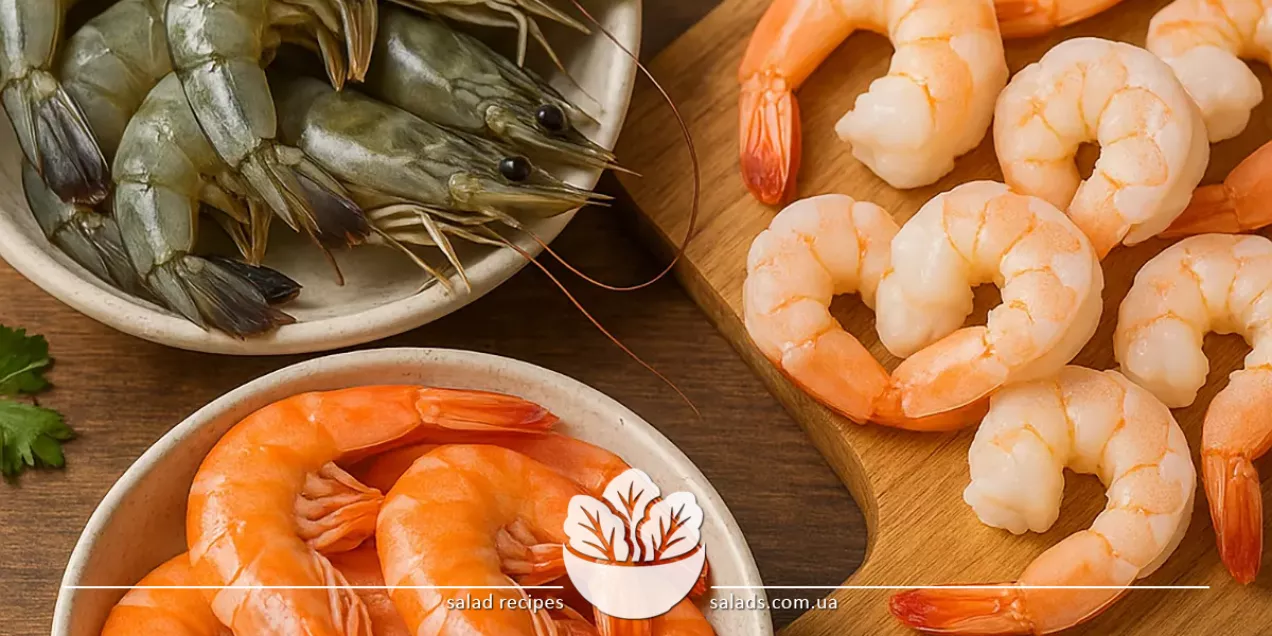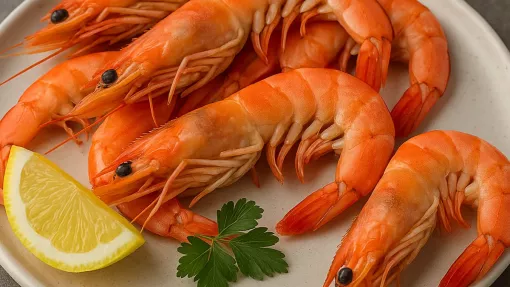Shrimp

Shrimp are among the most popular types of seafood, widely used in cuisines around the world. Their tender texture, slightly sweet flavor, and ease of preparation have made shrimp an indispensable ingredient in modern cooking. They are featured in salads, pasta, soups, Asian noodles, and even sandwiches. Shrimp pair perfectly with garlic, lemon, cream, cheese, and herbs. In addition to excellent taste, shrimp are highly nutritious – they are a source of protein, iodine, omega-3 fatty acids, and antioxidants. More information about other types of seafood can be found in the Seafood category, which includes products with similar properties.
Different Types of Shrimp
Classification of Shrimp by Origin
Shrimp are divided into saltwater and freshwater types – this is the first thing to consider when choosing a product. Saltwater shrimp are traditionally considered more flavorful, with a higher content of iodine and minerals. They are caught in the open sea and are most often sold frozen. Freshwater shrimp have a milder flavor, sometimes with sweet notes, and are often farmed. Both types are in demand but require different cooking methods – saltwater shrimp are best for frying, while freshwater ones are ideal for steaming or stewing. Shrimp are also classified by geographic origin. For example, Argentine red shrimp are known for their bright color and rich sea aroma. Tiger shrimp, commonly farmed in Asia, have firmer meat and can reach up to 30 cm in length. Northern shrimp are a separate category – small but extremely flavorful, often used in European cuisine for sandwiches, salads, and soups. It’s worth noting that while crabs also belong to the crustacean group, their meat has a completely different texture and culinary use. To compare their properties and culinary possibilities, see the crab category.
Shape, Size, and Shrimp Labeling
When buying shrimp, it’s important to consider not only freshness and country of origin but also size and processing method. The most common labeling system indicates the number of pieces per pound (approximately 450 g). For example, a 16/20 label means there are between 16 and 20 shrimp per pound – these are quite large. The smaller the number, the larger the shrimp. The smallest shrimp might be labeled 70/90 or even smaller and are typically used in salads or for garnish. Shrimp can be unpeeled, peeled, with or without tails, raw, or pre-cooked. Each type suits different culinary tasks: unpeeled – for broths and grilling, peeled – for quick meals, cooked – for cold appetizers. It’s important to remember that peeled shrimp lose moisture faster and may become tough if overcooked. Squid are also worth mentioning – though they are seafood too, their meat texture is entirely different. They are often served fried or stewed and are also used for stuffing. Culinary options for squid can be found in the squid category.
Nutritional Value and Benefits of Shrimp
Shrimp are considered one of the healthiest protein sources among seafood. 100 grams contain about 18-20 g of easily digestible protein with minimal fat content – up to 1.5 g. This makes shrimp a frequent part of diets for athletes, people with cardiovascular conditions, and those following a healthy lifestyle. They are low in calories but provide satiety and essential micronutrients. Shrimp are especially valued as a source of iodine, zinc, selenium, vitamin B12, and omega-3 fatty acids. These elements support thyroid function, the immune system, heart and blood vessels, and also improve skin health and cognitive functions. Shrimp also rank high among seafood in antioxidant content – thanks especially to astaxanthin, which gives their shells a pinkish-red color. A product with similar nutritional value is tuna – a fish high in protein, low in fat, and rich in flavor, ideal for baking, grilling, salads, and steaks. Learn more about it in the tuna category.
Culinary Uses of Shrimp
Shrimp are one of the most versatile ingredients in cooking. Thanks to their delicate flavor and quick preparation, they are used in a wide variety of dishes – from appetizers to main courses. They are ideal for pan-frying, oven baking, boiling in salted water, or grilling. Depending on size and type, shrimp are added to salads, pasta, risotto, Asian stir-fries, soups, broths, and curry dishes. In European cuisine, shrimp are often served in cold salads with eggs, vegetables, and mayonnaise-based dressings. Mediterranean recipes feature olive oil, garlic, lemon juice, and herbs. In Asia, shrimp are often cooked with soy sauce, ginger, sesame, or in sweet and sour sauces. Shrimp rolls are especially popular in Japanese cuisine, along with Thai tom yum soups and seafood noodles. For those on a strict diet, shrimp can be steamed or boiled without added fat. They also go well with creamy sauces, mushrooms, cheese, and even fruit – like pineapple or mango. If you prefer flavorful fish dishes, consider salmon – it pairs beautifully with the same sauces and side dishes as shrimp.
How to Choose and Store Shrimp
The quality of shrimp affects not only taste but also food safety. When buying, look at color, smell, body shape, and storage conditions. Fresh shrimp should have no off odors, with firm meat, a resilient tail, and an undamaged shell. A strong or ammonia-like smell indicates spoilage. Cooked shrimp are typically pink-orange, while raw ones are gray or slightly greenish. Frozen shrimp should be stored at -18°C, with no signs of refreezing (ice crusts, snow-like crystals). When purchasing vacuum-packed shrimp, check the seal, ingredients, and expiration date. Avoid unnecessary additives such as phosphates or preservatives that can affect flavor and texture. At home, it’s best to portion shrimp and freeze them right away. Fresh peeled shrimp stored in the fridge should be used within 1-2 days. Do not leave them at room temperature for more than 30 minutes. If you need something quick and easy, herring is also a good choice – it’s easy to store, ready to eat, and great for sandwiches or salads. More details can be found in the herring category.
